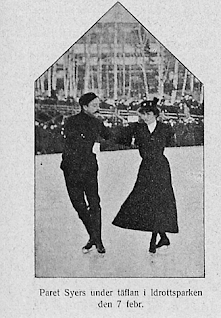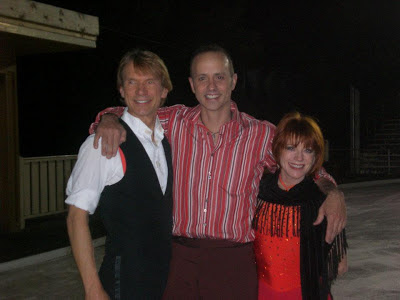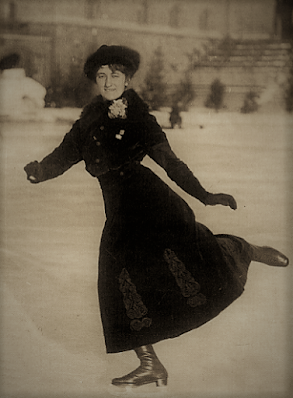A senior level figure skater and choreographer, Kate McSwain is one of the most important names you're going to need to remember when you're talking about the artistic revolution of the sport of figure skating which is now underway. An immensely talented choreographer, her own background as a skater earned her 3 gold medals at the National Showcase Artistic Competition and a bronze at ProSkater's Virtual Skate Off original performance competition. She has worked as a yoga, pilates and dance instructor for the last 6 years in addition to traveling the country working with VERY talented skaters including Jeremy Abbott, Caydee Denney and John Coughlin, Piper Gilles and Paul Poirier, Adam Rippon, Rachael Flatt, Alex Johnson, Drew Meekins, Wesley Campbell and many others. Her Sk8tivity program and work with Young Artists Showcase (YAS) and American
Ice Theatre (AIT) cement the fact that Kate is a skater and choreographer with the RIGHT vision about where the sport needs to be heading and I hope you'll enjoy Kate's answers to my questions as much as I did!Q: Tell me about your background in skating, what first drew you to the sport and what drew you to choreographing for other skaters.
A: I began skating late - around age ten - but quickly became serious, moving from my hometown in Kentucky to train and compete for 10 years out of the Detroit Figure Skating Club, followed by the Dallas Figure Skating Club, and finally the Broadmoor Figure Skating Club in Colorado Springs. When I retired from competition, I began pursuing a Theatre degree from the University of Colorado in Colorado Springs, which I obtained in 2008. I have known I wanted to be a choreographer since I was thirteen, so for half my life now. That is why my parents and I continued the difficult path of travelling and living apart so I could train; we all wanted to prepare me for a career in skating. Through the five years I spent working with my coach Allen Schramm - an artistic pioneer in skating in the seventies and eighties - my artistic skills and movement vocabulary were moulded and refined. Since I have graduated, I have been continuing my education and shaping my artistic philosophy by doing a Master Choreography Techniques (MCT) class with Jodi Porter of American Ice Theatre, who has also become my mentor. I also learned from Audrey Weisiger and through my participation in Young Artists Showcase (YAS). It is now my personal mission and passion to educate young skaters about how to create quality movement while skating, using tools and terms that allow them to identify the muscles they use to move with their core bodies. This is why I choreograph: I really want to help revolutionize the way skaters are being taught to move.
A: YAS is an innovative and challenging platform and opportunity for aspiring skating choreographers. There are not a lot of places a choreographer can have the freedom, support system, or professional feedback that YAS offers its contestants. As more young choreographers participate in YAS and more people watch and support it, only then will skaters, coaches, judges, and audiences begin to see the difference between high-quality, full-body movement, versus more simplistic skating. This concept is what we YAS alumni and other supporters of the education and promotion of quality artistic movement have begun to call the "artistic revolution." We believe a fundamental change is needed so that genuinely artistic skating - or the ART of skating - is understood and appreciated by professionals, taught to young skaters, and performed by trained artists. I hope to participate in YAS4! The last time I participated in YAS was the inaugural year (2010), and I hope to challenge myself and continue to develop my craft through the five challenges in the competition this summer. I always want to keep myself sharp, and make sure I am staying fresh with my movement and choreo choices, and I believe YAS4 will inspire me and help me refine my skills.
Q: What skater would you most like to meet that you haven't yet? Choreograph a program for?
A: I would love to meet and talk to Toller Cranston or the late John Curry. I would like to pick both of their brains and know what millions of ideas they have to expand the art in figure skating. They were the beginnings of the artistic movement, and I wish I could have the opportunity to learn from them in person. Jeffrey Buttle, Stephane Lambiel, Joannie Rochette, and Meryl and Charlie are the skaters I wish I could choreograph for! All of these skaters are legends, and watching them skate is an experience that one will never forget. They are the types of skaters that will continue to push the artistic envelope in skating.
Q: What is the most overused piece of music in figure skating?
A: There are so many! "Carmen", "Ave Maria", "Firebird", "All That Jazz", "Phantom of the Opera"…and I could go on because, unfortunately, there are lots. It’s time for change. And I hope the new rule permitting lyrics after this season will really help widen music choices and increase creativity in choreography, both of which will hopefully significantly expand figure skating's (sadly) dwindling audiences.
Q: What can you tell us about your choreographic process?
A: My process is different depending upon the piece, the audience, and the amount of time I have to prepare. When time allows, I choreograph everything in my head beforehand and draw it out on paper with all the counts and formations so I feel prepared when teaching it to the skaters. I definitely prefer to have the spatial design and highlights of a piece outlined first, and to fill in the movement later using improvisation and work with the individual skater to identify his/her unique strengths.
Sometimes, though, especially when I am on a tight deadline, I create by improvisation and trusting my gut. Overall, the integral part of choreography that inspires me the most is allowing my body to be completely free and move to the music as if my movements were playing the notes as I hear them.
Q: Who's your skating idol? Who's one skater you love that not many people may know about?
A: My idol is Michelle Kwan because she is the whole package, both on and off the ice. She moved audiences through her musicality and fluidity, and at the same time, she is as classy, positive, and polished as they come. She is a wonderful role model for young skaters. Currently, my favorite skaters are Meryl and Charlie. Their level of artistry in skating is, in my opinion, absolutely flawless.
As for lesser-known but also excellent skaters, I love Wesley Campbell, Alex Johnson, Hannah Miller, Jonathan Cassar, Garrett Kling, Adam Blake, Piper Gilles and Paul Poirier, Kim Navarro and Livvy Shilling. (I can’t just pick one!) These skaters are all talented, passionate, and eager to learn. With these skaters’ energy and enthusiasm—and many others like them—we will be able to continue to move the “artistic revolution” further along.
Q: What are your goals these days and where do you see yourself in five years?
A: My goals are to continue choreographing for elite competitive skaters, ensembles, and large productions, always challenging myself by being open to growth and development and constantly working to improve, never plateau. In addition, I would like to establish a company branch of American Ice Theatre (AIT) on the East Coast, opening another venue for professional skaters to perform and for young choreographers to present their work. This branch of AIT would also educate young training skaters on how to move their bodies using classes and resources such as my “Sk8tivity” artistic clinics, the newly re-launched Ricky Harris Clinics, as well as the Master Choreography Techniques online class I mentioned, put on by AIT. Above all, I hope I help move the level of artistry in the sport higher, because I am just very passionate about making the effort to supply skaters from a young age (as low as Pre-Preliminary) with the tools they need to skate properly, using their full bodies and understanding movement that starts from the core. Only then will we see the next generation arise, both expecting and executing higher standards of artistry.
Q: What are your thoughts on professional figure skating? It was MASSIVE in the 1990's and professional figure skating competitions are few and far between these days.
A: I think professional figure skating is a wonderful outlet for spectators of the sport and I would love if it had a resurgence! However, I think there should be a lot more outlets for amateur skaters to pursue success and accomplishment through skating as well. In addition to professional skating competitions, I would like to see more emphasis overall on other possible future paths for skaters—such as synchro, professional ice theatre companies, show skating, and test track. I think that if parents and skaters approached the sport with fewer expectations of the Olympics and greater awareness of the many opportunities and benefits to the other avenues as well, the sport would have many more participants and spectators. As a side note, I also think a reality TV show such as "So You Think You Can Skate" could be hugely popular, since it would have already professionally trained skaters competing on an artistic level. I really hope we can turn over a new leaf with the popularity of the sport and I think the first step is envisioning and popularizing more paths than just the classic competitive track.
Q: What's your favourite song and why?
A: The answer to this is constantly changing because I think it’s really important to stay connected to fresh, contemporary artists in order to keep skaters and audiences interested. I try to find new artists and different sounds all the time, but that requires ongoing research and keeping my library up-to-date, both of which require time and money! I will say that some of my all-time favourite artists are Xavier Rudd, Mika, Beyonce (she never gets old!), Amy Winehouse, Yann Tiersen, Paloma Faith, Mumford and Sons, Miss Li and - of course - Barbara Streisand.
Q: What has been the most memorable experience you have ever had on the ice?
A: The opportunity to skate this past March at the Rockefeller Center in New York City with the New Voices in Figure Skating show presented by YAS and Ice Theatre of New York was absolutely a dream come true for me on every level. I had the chance to perform with one of my best friends and fellow choreographer Garrett Kling, and at the same time got to showcase some of my choreography at the most famous rink in the world. I will never forget taking my beginning pose and looking up to see the famous New York City skyline—it gave me a joy and an excitement I have never experienced before.
Skate Guard is a blog dedicated to preserving the rich, colourful and fascinating history of figure skating. Over ten years, the blog has featured over a thousand free articles covering all aspects of the sport's history, as well as four compelling in-depth features. To read the latest articles, follow the blog on Facebook, Twitter, Pinterest and YouTube. If you enjoy Skate Guard, please show your support for this archive by ordering a copy of the figure skating reference books "The Almanac of Canadian Figure Skating", "Technical Merit: A History of Figure Skating Jumps" and "A Bibliography of Figure Skating": https://skateguard1.blogspot.com/p/buy-book.html.

















.jpg)


.jpg)










